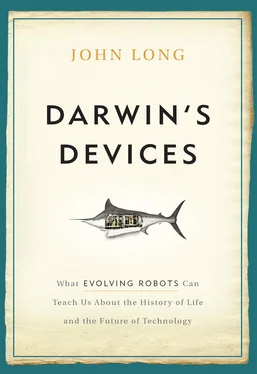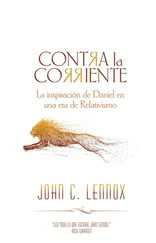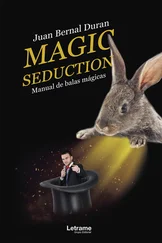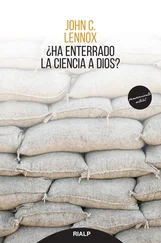In the water world, sun represents food. The first food, for almost all life, is the glucose made by plants that harvest the energy from light. In the ocean most critters follow the light to find the food. That’s why most of the sea creatures live in the upper reaches, the shallower depths, because that’s where the light is. And where there is light, there are algae and diatoms, the “primary producers” making the stuff, their fronds and bodies, that feeds the mobile, self-propelled critters like fish.
The world sets the stage for what matters in the game of life—surviving and reproducing better than other agents in your population: outwit, outplay, out-reproduce. [28] Yes, I’m referencing the television show Survivor on CBS. Their logo reads, “Outwit, outplay, outlast.” I in no way mean to imply that reproduction is or should be part of this show.
DESIGN QUESTION 4: WHAT IS THE SELECTION PRESSURE THAT WE APPLY AND WHY WAS IT CHOSEN?
Honestly, no one has any idea what the selection pressures were that drove the evolution of the early vertebrates. As we discussed in Chapter 2, it’s difficult enough to understand what is going on when you have live animals right in front of you. Even then you have to know the evolutionary fitness of different individuals and link their many phenotypic differences to differences in how the individuals behave and interact with their world over their entire lifetimes. This is a daunting task under the best of conditions with live animals. For extinct animals, all we can do is make what seem to be reasonable guesses, or what Brandon called “how-possibly” explanations.
So how do we make reasonable guesses—hypotheses—about selection pressures that drove early vertebrate evolution? We use our understanding of how specific traits function in living animals, assume the same thing was happening long ago, and then conjecture that variations in that trait had functional consequences for the individuals possessing those variations that could help or hinder them in the game of life. We then imagine the conditions of the world, with its physical characteristics and other autonomous organic agents, under which that help or hindrance would matter the most for survival and reproduction. That particular condition of the world is our “selection environment,” to use Brandon’s term from Chapter 2, and the “selection pressure” that we are talking about here is the particular type of interaction between the selection environment and the individuals that most affect survival and reproduction. For example, many people think that avoiding predators is the selection pressure that drives the evolution of fish coloration, body shape, and swimming performance. [29] Cameron K. Ghalambor, Jeffrey A. Walker, and David N. Reznick, “Multi-trait Selection, Adaptation, and Constraints on the Evolution of Burst Swimming Performance,” Integrative and Comparative Biology 43, no. 3 (2003): 431–438. Also see R. B. Langerhans, “Predicting Evolution with Generalized Models of Divergent Selection: A Case Study with Poeciliid Fish,” Integrative and Comparative Biology 50, no. 6 (2010): 1167–1184.
We focus our educated guessing on the axial skeleton and the evolutionary change from notochords to vertebrae. As explained above, Tadro3s are built to evolve the structural stiffness of their tails as a proxy for the presence of vertebrae. With tail stiffness in mind, we first think about the mechanical function of the tail: what does it do and how does it do it?
The primary mechanical function of the chordate tail, the section of the body behind the gut and including the terminal caudal fin, appears to be propulsion. No surprise. Tunicate tadpoles, sharks, and bony fish all undulate their tails to create thrust. Undulation is making waves, traveling waves of body flexion that start near the head and move toward the caudal fin. By altering the shape and speed of those undulatory waves, fish alter their swimming speed, turn, and brake.
The structural stiffness of the tail controls, in part, the shape and speed of the undulatory waves. If you’ve ever tuned the string of a guitar or violin, you know that if you tighten the string, it will vibrate faster when plucked, creating a higher pitch. By tightening the string, you’ve stiffened it, and it is a well-known principle of engineering that an elastic structure like a string or steel bridge will tend to vibrate at a particular frequency, called the natural frequency, that is determined by the structure’s stiffness, mass, and ability to dissipate energy. Thus, stiffer tails ought to vibrate faster than flexible tails.
So how might have the stiffness of tails evolved? What might have been the selection pressure? Here we connect the dots. If increased tail stiffness makes or allows the undulatory waves to travel faster, then increased tail stiffness increases the speed at which fish can swim. If increased swimming speed helps fish find food, then increased tail stiffness increases the amount of food that a fish can eat. And finally, if finding and eating more food increases a fish’s chances of survival and its reproductive success, then increased tail stiffness was selected to improve the ability to forage and feed.
We put the feeding selection pressure into action by coming up with a “fitness function,” which is a fancy name for a numerical formula for judging how well each individual does relative to the other individuals in the population. Because foraging and feeding involve detecting the presence of the food, traveling to the food source, and then staying and eating, we reasoned that a number of behaviors should be rewarded at the same time. First, the ability to detect the food could be measured as the time it took a Tadro3 to reach the source; more points are given for shorter times. Second, the ability to get to the food quickly could be measured by the average speed at which the Tadro3 traveled; more points are given for higher speeds. Third, staying and eating could be measured by the average distance of each Tadro3 from the food source; more points are given for a shorter distance. Fourth and finally, the sloppiness of swimmers that waste energy, and thus food, could be measured by their average amount of body wobble ; more points are given for smaller amounts of wobble.
DESIGN QUESTION 5: HOW DOES THE EVOLVABOT AND ITS WORLD, TAKEN TOGETHER, REPRESENT THE ANIMAL AND ITS WORLD?
Our earliest Chordate ancestors were probably little fish-like swimmers, with notochords for an axial skeleton in their body and tail and with at least a single eyespot. They could probably detect and navigate relative to light gradients in the sea. This simplified and hypothetical ancestor is inferred from what we know about living chordates and Cambrian vertebrates (see Figure 3.2), development of living vertebrates, and the evolutionary relationships among chordates that we reconstruct using phenotypes and genomic data.
Using this information, we chose as our specific biological target the tadpole larva of living tunicates. Even though no living species is the ancestor to another living species, we still felt confident enough in the similarities between the behavior of tunicate tadpole larvae and the ancient, extinct chordates to use the larva as our model for designing Tadro3. The Tadro3 uses the same neural algorithm that we think the tadpoles use, both have a single eyespot, and both continuously undulate a tail with a notochord. To flap the tail, the Tadro3 uses a single motor instead of a series of muscle cells distributed along the tail. Both Tadro3s and tadpoles turn by adjusting the angle at which the tail meets the body.
We did simplify things, however, by having Tadro3 swim just on the surface of the water rather than underneath and by building the Tadro3 on a scale easy for us humans to manipulate. Tadro3 is about twenty-five centimeters from head to tail; a tadpole larva, however, is just a few millimeters long. We also simplified, as I described above, the physical environment: Tadro3 lives in a small circular pool rather than the ocean. Feeding behavior is also simplified, as Tadro3 merely needs to navigate up the light gradient cast by the single light over the pool. Likewise, although tadpoles encounter many other animals in a twelve-to twenty-four-hour dispersal period, during which most tadpoles die, our robots encountered no other agents (just other Tadro3s), “dispersed” for just three minutes, and could not “die.”
Читать дальше












